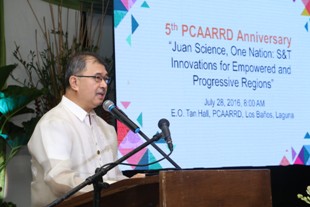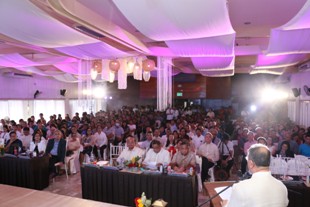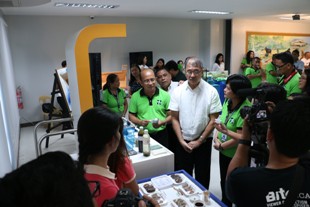
De la Peña urged the call as he keynoted the 5th anniversary celebration of the Philippine Council for Agriculture, Aquatic and Natural Resources Research and Development, Department of Science and Technology (DOST-PCAARRD) on July 28, the fourth day of the National Science and Technology Week (NSTW) celebration.
Speaking before PCAARRD officials and staff, representatives from the Council’s partner agencies, scientists, researchers, academicians, and the media at the PCAARRD Complex in Los Baños, Laguna, de la Peña congratulated the Council in having continually pursued a focused and meaningful research and development (R&D) undertaking for the AANR, even as he urged the Council and its partners for an intensified and vigorous R&D stance.
“The last five years of PCAARRD bears witness to how the Council has been instrumental in breaking new grounds in agri-aqua R&D through its four banner programs: Strategic R&D, R&D Results Utilization, Policy Research and Advocacy; and Capability Building and Governance,” De la Peña said.

SIPAG FIESTA showcased some of the Council’s leading technologies in a grand display of R&D outputs as the term of the previous administration drew to a close in March this year. These technologies included plant growth promoter from gamma irradiated Carrageenan; Smarter Agriculture Technology; Coconut somatic embryogenesis; Shrimp biofloc technology; and High-yielding and virus-resistant abaca, among others.
Aside from these technologies, though, de la Peña said that having gone through the NSTW 2016 exhibits at the PCAARRD Complex this year, he found other interesting technologies on food commodities such as goat, duck, pig, native chicken, and those that concern the production and propagation of oysters, mussels, abalone, and the hatcheries for blue crab.
De la Peña challenged the Council and its partners to further intensify its share in alleviating poverty, especially in the countryside, as he inspired them with the hope of millions of Filipinos that change is coming, particularly in terms of government’s role in poverty reduction through science and technology.
“PCAARRD continually faces the challenge of improving the lives of marginalized sectors of society through worthwhile and productive research and development strategies,” de la Peña said.

As he tackled the issue of farmers and fisherfolk empowerment, de la Peña likewise inspired PCAARRD and its partners with the challenge of intensifying its effort in improving the lives of about 47% of Filipinos, who depend on the agri-aqua sectors for their livelihood. He explained that empowering these sectors necessarily requires more efficient agriculture—one that uses less resources to make more food.
De la Peña regrets the decreasing human resource needed for agricultural productivity, particularly the aging workforce in the agricultural sector, as well as the decreasing number of students who pursue agriculture related courses. He noted that the average age of farmers is 57 years old, and the number of students who enrol in agriculture-related courses is now only 3% from 60%.
Reacting to this concern, de la Peña said that DOST has to bring back agriculture as a priority course in its scholarship program.
The Secretary likewise underscored the value of more partnership initiatives especially in the regions to ensure efficient rolling out of technologies for the benefit not only of farmers and fisherfolk but that of the country’s micro, small and medium enterprises as precursors of development.
